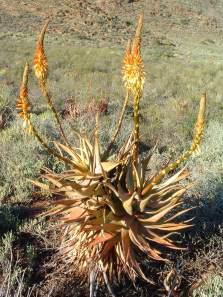Aloe microstigma
Aloe microstigma Salm-Dyck
Family: Asphodelaceae
Common names: Karoo aloe, small-spotted aloe (Eng.); karoo-aalwyn (Afr.)
Introduction
Aloe microstigma is one of the most floriferous aloes in South Africa. It is a common and widespread species that transforms the dull winter landscape into a wonderland with its towering warm colours that resembles flames on candles.

Description
Description
These plants reach a height of about 600 mm and usually occur singularly or in small groups. The leaves are arranged in rosettes and are blue-green but can turn reddish brown if suffering from environmental stress. Conspicuous white spots appear on the leaves, which contrast well with the reddish teeth along the margins. The plant usually produces two or three flowers simultaneously in early winter, from May to July. The inflorescences (stem on which all flowers are borne) are up to 1m. The flowers are bicoloured, with red buds turning orange. In some places, however, the buds and open flowers may be uniformly red or yellow.
Conservation Status
Status
Aloe microstigma is not threatened.
Distribution and habitat
Distribution description
Aloe microstigma is very common and widely distributed in the dry interior of the Northern, Western and Eastern Cape Provinces and southern Namibia. It is found in a wide variety of habitats, in flat open areas, steep rocky slopes, or amongst bushes. Plants do exceptionally well in cultivation and prefer dry gardens. One can also grow them in very wet gardens, if drainage is good. Plants are drought tolerant, but the flowers are easily damaged by frost.
Derivation of name and historical aspects
History
The scientific name accurately describes the distinguishing feature of the plant, microstigma means 'very small spot'.
There are about 350 species of Aloe, found in Africa, Arabia, Madagascar and Socotra. About 126 of these occur in South Africa. Aloes were traditionally grouped with other lily-like plants under the family Liliaceae. Some of their close relatives are Gasteria, Haworthia, Knophofia, Bulbinella, Bulbine, Astroloba, and Trachyandra.
Ecology
Ecology
Aloe microstigma is pollinated primarily by sunbirds particularly the Lesser Double-collard Sunbird, which extracts the nectar produced by the flowers. Insects may also be responsible for pollination. Seeds are produced in abundance and this serves as a survival mechanism. They are small, black to 2 mm in diameter, inconspicuously winged and wind dispersed. Seeds are parasitized by small day flies that lay their eggs in the seeds, their larvae then live off the seeds. The success of germination is relatively high giving rise to the abundance of the species.
The rosette of leaves helps to cool the plant in that the upper leaves provides shading for the lower ones. Another interesting adaptation is the inward folding of leaves during the hot summer months. This helps to protect the softer and younger leaves from extreme temperatures. Leaves unfold again in cool weather.
Uses
Use
Aloe microstigma is not recorded as a medicinal plant but it is said that the bitter sap has healing properties in cases of cuts and burn wounds. Plants are more favoured for their use in horticulture. They make particularly nice low maintenance garden plants which are especially attractive when in flower in the barren winter months.
Growing Aloe microstigma
Grow
These plants should be grown in sunny, somewhat sheltered and well drained areas. They are ideal plants for a difficult or neglected part of the garden and with the addition of other suitable plants can create stunning rock gardens. Companion plants such as Cotyledon orbiculata, Tylecodon paniculatus, Crassula arborescens, Aloe dichotoma, Aloe brevifolia, Pelargonium crithmifolium, Pelargonium sericifolia, etc., are ideal to start a rock garden.
Aloe microstigma is best grown from fresh seeds that are sown in summer or autumn. A coarse sandy medium must be used and seeds are sprinkled lightly and covered slightly with sand. If kept moist, (not wet) seeds germinate within two weeks. The most common pests on Aloe microstigma are scale, the aloe snout beetle, and aphids. These can all be successfully treated with contact or systemic pesticides. If plants are to be fed, use only organic based fertilisers in a liquid solution. These can be applied as a soil drench or sprayed on plants once a month. Another good plant food for aloes is bone meal. Bone meal is mixed in the soil and works wonders especially when planting or transplanting aloes.
References
- Van Wyk, B-E and Smith, G. 1996. Guide to Aloes of South Africa. Pretoria, Briza Publications.
- Goldblatt, P and Manning, J. 2000. Cape Plants. Cape Town, NBI & Missouri NBG.
Credits
Werner Voigt
Karoo Desert National Botanical Garden
July 2003
Plant Attributes:
Plant Type: Shrub, Succulent
SA Distribution: Eastern Cape, Northern Cape, Western Cape
Soil type: Sandy
Flowering season: Autumn, Winter
PH:
Flower colour: Red, Yellow, Orange
Aspect: Full Sun
Gardening skill: Easy
Special Features:
Horticultural zones








Rate this article
Article well written and informative
Rate this plant
Is this an interesting plant?
Login to add your Comment
Back to topNot registered yet? Click here to register.